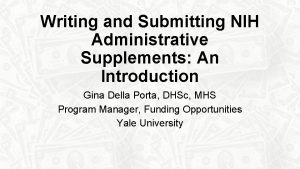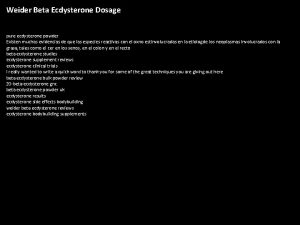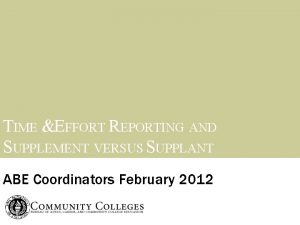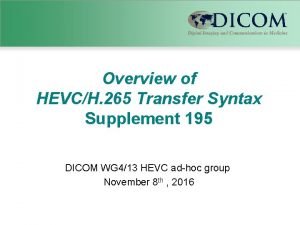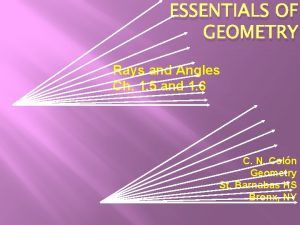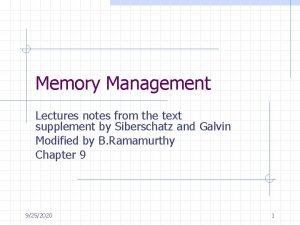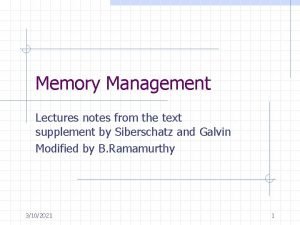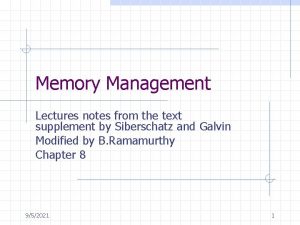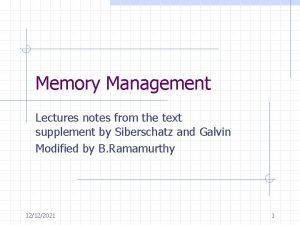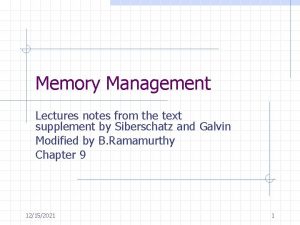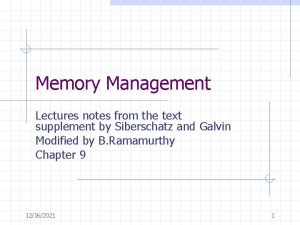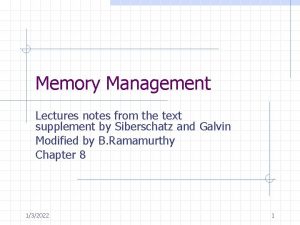Memory Management Lectures notes from the text supplement
























- Slides: 24

Memory Management Lectures notes from the text supplement by Siberschatz and Galvin Modified by B. Ramamurthy Chapter 9 9/25/2021 1

Binding of Instructions and Data to Memory Address binding of instructions and data to memory addresses can happen at three different stages. Compile time: If memory location known a priori, absolute code can be generated; must recompile code if starting location changes. Load time: Must generate relocatable code if memory location is not known at compile time. Execution time: Binding delayed until run time if the process can be moved during its execution from one memory segment to another. Need hardware support for address maps (e. g. , base and limit registers). 9/25/2021 2

Dynamic relocation using a relocation register 9/25/2021 3

Dynamic Loading Routine is not loaded until it is called Better memory-space utilization; unused routine is never loaded. Useful when large amounts of code are needed to handle infrequently occurring cases. No special support from the operating system is required implemented through program design. 9/25/2021 4

Dynamic Linking postponed until execution time. Small piece of code, stub, used to locate the appropriate memory-resident library routine. Stub replaces itself with the address of the routine, and executes the routine. Operating system needed to check if routine is in processes’ memory address. Dynamic linking is particularly useful for libraries. 9/25/2021 5

Overlays Keep in memory only those instructions and data that are needed at any given time. Needed when process is larger than amount of memory allocated to it. Implemented by user, no special support needed from operating system, programming design of overlay structure is complex 9/25/2021 6

Swapping A process can be swapped temporarily out of memory to a backing store, and then brought back into memory for continued execution. Backing store – fast disk large enough to accommodate copies of all memory images for all users; must provide direct access to these memory images. Roll out, roll in – swapping variant used for prioritybased scheduling algorithms; lower-priority process is swapped out so higher-priority process can be loaded and executed. 9/25/2021 7

Schematic View of Swapping 9/25/2021 8

Contiguous Allocation Main memory usually into two partitions: n Resident operating system, usually held in low memory with interrupt vector. n User processes then held in high memory. Single-partition allocation n Relocation-register scheme used to protect user processes from each other, and from changing operating-system code and data. n Relocation register contains value of smallest physical address; limit register contains range of logical addresses – each logical address must be less than the limit register. 9/25/2021 9

Hardware Support for Relocation and Limit Registers 9/25/2021 10

Contiguous Allocation (Cont. ) Multiple-partition allocation n Hole – block of available memory; holes of various size are scattered throughout memory. n When a process arrives, it is allocated memory from a hole large enough to accommodate it. n Operating system maintains information about: a) allocated partitions b) free partitions (hole) OS OS process 5 process 9 process 8 process 2 9/25/2021 process 10 process 2 11

Dynamic Storage-Allocation Problem How to satisfy a request of size n from a list of free holes. First-fit: Allocate the first hole that is big enough. Best-fit: Allocate the smallest hole that is big enough; must search entire list, unless ordered by size. Produces the smallest leftover hole. Worst-fit: Allocate the largest hole; must also search entire list. Produces the largest leftover hole. First-fit and best-fit better than worst-fit in terms of speed and storage utilization. 9/25/2021 12

Fragmentation External Fragmentation – total memory space exists to satisfy a request, but it is not contiguous. Internal Fragmentation – allocated memory may be slightly larger than requested memory; this size difference is memory internal to a partition, but not being used. Reduce external fragmentation by compaction n Shuffle memory contents to place all free memory together in one large block. n Compaction is possible only if relocation is dynamic, and is done at execution time. n I/O problem w Latch job in memory while it is involved in I/O. w Do I/O only into OS buffers. 9/25/2021 13

Paging Logical address space of a process can be noncontiguous; process is allocated physical memory whenever the latter is available. Divide physical memory into fixed-sized blocks called frames (size is power of 2, between 512 bytes and 8192 bytes). Divide logical memory into blocks of same size called pages. Keep track of all free frames. To run a program of size n pages, need to find n free frames and load program. Set up a page table to translate logical to physical addresses. Internal fragmentation. 9/25/2021 14

Address Translation Scheme Address generated by CPU is divided into: n Page number (p) – used as an index into a page table which contains base address of each page in physical memory. n Page offset (d) – combined with base address to define the physical memory address that is sent to the memory unit. 9/25/2021 15

Address Translation Architecture 9/25/2021 16

Paging Example 9/25/2021 17

Paging Example 9/25/2021 18

Free Frames Before allocation 9/25/2021 After allocation 19

Implementation of Page Table Page table is kept in main memory. Page-table base register (PTBR) points to the page table. Page-table length register (PRLR) indicates size of the page table. In this scheme every data/instruction access requires two memory accesses. One for the page table and one for the data/instruction. The two memory access problem can be solved by the use of a special fast-lookup hardware cache called associative memory or translation look-aside buffers (TLBs) 9/25/2021 20

Paging Hardware With TLB 9/25/2021 21

Effective Access Time Associative Lookup = time unit Assume memory cycle time is 1 microsecond Hit ratio – percentage of times that a page number is found in the associative registers; ration related to number of associative registers. Hit ratio = Effective Access Time (EAT) EAT = (1 + ) + (2 + )(1 – ) =2+ – 9/25/2021 22

Inverted Page Table One entry for each real page of memory. Entry consists of the virtual address of the page stored in that real memory location, with information about the process that owns that page. Decreases memory needed to store each page table, but increases time needed to search the table when a page reference occurs. Use hash table to limit the search to one — or at most a few — page-table entries. 9/25/2021 23

Inverted Page Table Architecture 9/25/2021 24
 Text to text text to self text to world
Text to text text to self text to world Oral communication 3 lectures text
Oral communication 3 lectures text Activity planning software project management
Activity planning software project management Prototype in semantics
Prototype in semantics Implicit and explicit memory
Implicit and explicit memory Long term memory vs short term memory
Long term memory vs short term memory Internal memory and external memory
Internal memory and external memory Primary memory and secondary memory
Primary memory and secondary memory Memory swaping
Memory swaping Which memory is the actual working memory?
Which memory is the actual working memory? Virtual memory
Virtual memory Virtual memory in memory hierarchy consists of
Virtual memory in memory hierarchy consists of Eidetic memory vs iconic memory
Eidetic memory vs iconic memory Shared vs distributed memory
Shared vs distributed memory Administrative supplement nih
Administrative supplement nih Beta existeron
Beta existeron Supplement vs supplant
Supplement vs supplant Syntex supplement
Syntex supplement What is the supplement of an angle measuring 113º?
What is the supplement of an angle measuring 113º? Perbedaan feed additive dan feed supplement
Perbedaan feed additive dan feed supplement Dietary supplement definition
Dietary supplement definition Texas autism supplement example
Texas autism supplement example Doh-5178a
Doh-5178a Data wharehouse
Data wharehouse Doh 4220 supplement a
Doh 4220 supplement a














